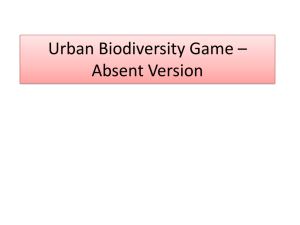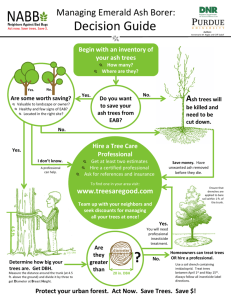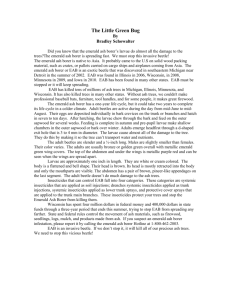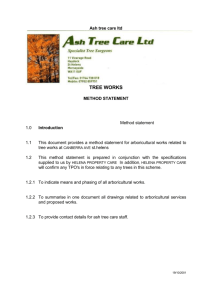Fraxinus Populations in Areas Long Infested by Agrilus planipennis Kathleen S. Knight,
advertisement
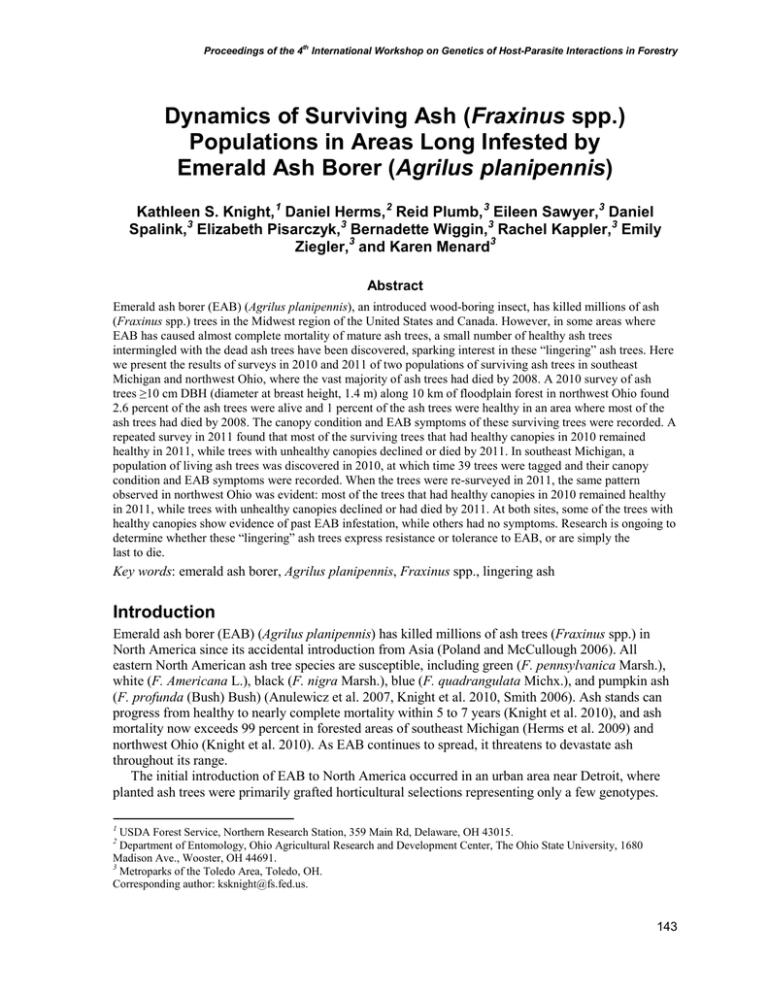
Proceedings of the 4th International Workshop on Genetics of Host-Parasite Interactions in Forestry Dynamics of Surviving Ash (Fraxinus spp.) Populations in Areas Long Infested by Emerald Ash Borer (Agrilus planipennis) Kathleen S. Knight, 1 Daniel Herms, 2 Reid Plumb, 3 Eileen Sawyer,3 Daniel Spalink,3 Elizabeth Pisarczyk,3 Bernadette Wiggin,3 Rachel Kappler,3 Emily Ziegler,3 and Karen Menard3 Abstract Emerald ash borer (EAB) (Agrilus planipennis), an introduced wood-boring insect, has killed millions of ash (Fraxinus spp.) trees in the Midwest region of the United States and Canada. However, in some areas where EAB has caused almost complete mortality of mature ash trees, a small number of healthy ash trees intermingled with the dead ash trees have been discovered, sparking interest in these “lingering” ash trees. Here we present the results of surveys in 2010 and 2011 of two populations of surviving ash trees in southeast Michigan and northwest Ohio, where the vast majority of ash trees had died by 2008. A 2010 survey of ash trees ≥10 cm DBH (diameter at breast height, 1.4 m) along 10 km of floodplain forest in northwest Ohio found 2.6 percent of the ash trees were alive and 1 percent of the ash trees were healthy in an area where most of the ash trees had died by 2008. The canopy condition and EAB symptoms of these surviving trees were recorded. A repeated survey in 2011 found that most of the surviving trees that had healthy canopies in 2010 remained healthy in 2011, while trees with unhealthy canopies declined or died by 2011. In southeast Michigan, a population of living ash trees was discovered in 2010, at which time 39 trees were tagged and their canopy condition and EAB symptoms were recorded. When the trees were re-surveyed in 2011, the same pattern observed in northwest Ohio was evident: most of the trees that had healthy canopies in 2010 remained healthy in 2011, while trees with unhealthy canopies declined or had died by 2011. At both sites, some of the trees with healthy canopies show evidence of past EAB infestation, while others had no symptoms. Research is ongoing to determine whether these “lingering” ash trees express resistance or tolerance to EAB, or are simply the last to die. Key words: emerald ash borer, Agrilus planipennis, Fraxinus spp., lingering ash Introduction Emerald ash borer (EAB) (Agrilus planipennis) has killed millions of ash trees (Fraxinus spp.) in North America since its accidental introduction from Asia (Poland and McCullough 2006). All eastern North American ash tree species are susceptible, including green (F. pennsylvanica Marsh.), white (F. Americana L.), black (F. nigra Marsh.), blue (F. quadrangulata Michx.), and pumpkin ash (F. profunda (Bush) Bush) (Anulewicz et al. 2007, Knight et al. 2010, Smith 2006). Ash stands can progress from healthy to nearly complete mortality within 5 to 7 years (Knight et al. 2010), and ash mortality now exceeds 99 percent in forested areas of southeast Michigan (Herms et al. 2009) and northwest Ohio (Knight et al. 2010). As EAB continues to spread, it threatens to devastate ash throughout its range. The initial introduction of EAB to North America occurred in an urban area near Detroit, where planted ash trees were primarily grafted horticultural selections representing only a few genotypes. 1 USDA Forest Service, Northern Research Station, 359 Main Rd, Delaware, OH 43015. Department of Entomology, Ohio Agricultural Research and Development Center, The Ohio State University, 1680 Madison Ave., Wooster, OH 44691. 3 Metroparks of the Toledo Area, Toledo, OH. Corresponding author: ksknight@fs.fed.us. 2 143 GENERAL TECHNICAL REPORT PSW-GTR-240 No resistance to EAB was observed in these populations. Later, EAB spread into forests with greater genetic variation among trees. Healthy, living ash trees have been observed in areas infested by EAB for several years where the vast majority of ash trees have been dead for a few years; these healthy trees have been termed “lingering ash.” Lingering ash trees are intermingled with dead ash trees with EAB symptoms, so it is unlikely that they are escapes. It is possible that these are simply the last trees to die, as EAB remains in these areas, but at low densities (Knight et al. 2010). It is also possible that these trees are resistant or tolerant to EAB and have either remained healthy or recovered from EAB damage. Objectives: 1. Determine the incidence of ash survival at a site in northwest Ohio where “lingering ash” have been observed. 2. Study the population dynamics and health of surviving ash populations over time at a site in northwest Ohio and a site in southeast Michigan Methods Two populations of surviving ash trees, one in northwest Ohio and one in southeast Michigan (fig. 1), were surveyed in 2010 and 2011 using the method described by Smith (2006) for rating canopy condition and recording symptoms of EAB. Canopy condition was rated on a 1 to 5 scale, where 1 is a healthy tree, 5 is a dead tree, and 2 to 4 are progressive stages of thinning and dieback (fig. 2). Tree stress symptoms associated with EAB activity were recorded as present or absent. These symptoms include woodpecker holes and EAB exit holes visible on the tree trunk, splitting bark, new epicormic shoots, and basal sprouts. Each tree’s trunk diameter at 1.38 m height (DBH) and the global position coordinates were also recorded. Living ash trees surveyed in 2010 were re-surveyed in 2011 using the same methods. Figure 1—Study sites: Oak Openings Preserve Metropark in northwest Ohio and Indian Springs Metropark in southeast Michigan. 144 Proceedings of the 4th International Workshop on Genetics of Host-Parasite Interactions in Forestry 1 2 3 4 5 Figure 2—Photos showing ash canopy condition rating scale (Smith 2006). (Photos: D.A. Herms) Northwest Ohio Oak Openings Preserve Metropark, located in western Lucas County, Ohio, is a nearly 2,024 ha nature preserve in the heart of the Oak Openings region. This biologically rich region, formed at the western shore of the ancient glacial lakes Warren, Wayne, and Lundy, has extensive deposits of sand underlain by a glacial till consisting of drainage-impeding clay minerals (Brewer and Vankat 2004). Variations in sand and soil depth, pH, moisture, and elevation create a multitude of habitats ranging from sand blowouts, sand barrens, black oak savannas, wet prairies, and floodplain forests (Easterly 1976). The original floodplain forests of the early 1800s were dominated by American elm (Ulmus americana L.), black willow (Salix nigra Marsh.), green ash, sycamore (Platanus occidentalis L.), basswood (Tilia americana L.) and quaking aspen (Populus tremuloides Michx.), with less dominant species of silver maple (Acer saccharinum L.), red oak (Quercus rubra L.), Ohio buckeye (Aesculus glabra Willd.), honey locust (Gleditsia triacanthos L.), and hackberry (Celtis occidentalis L.) (Brewer and Vankat 2004). Although successive waves of drainage, urbanization, fire-suppression, farming, and lumbering have dramatically fragmented the landscape, this region nevertheless remains home to over 140 state and federally listed species (Brewer and Vankat 2004). The modern floodplain is a mix of closed-crown floodplain forest and areas of herbaceous vegetation with scattered trees. The study area was located along the 10 km section of the Swan Creek floodplain that resides within the Oak Openings Preserve Metropark boundaries (fig. 3). The study area encompassed approximately 1 km2 of the 1.23 km2 100-year floodplain. We surveyed living ash trees (foliage present) ≥10 cm DBH within 50 m of the creek, and, in addition, dead ash and other live or dead tree species in 20 plots systematically placed every 1,000 m along the length of the river. In areas where the floodplain was wider than 50 m, trees beyond 50 m were not surveyed, and in areas where the floodplain was less than 50 m wide, we surveyed to the edge of the floodplain. Additional living ash trees that were discovered in 2011 were measured and recorded as well. The 20 plots for surveying standing dead ash trees, and other tree species, were 100 m long and 50 m wide. Plots were located within the 100-year floodplain using geographical information system in areas where the floodplain was 50 m wide and approximately 1,000 m intervals along the contour of Swan Creek. Approximately 10 percent of the length of Swan Creek was included in the plots. Information recorded on trees in these plots included DBH and global position. By 2010, many ash trees had already fallen and were difficult to tally as they washed downstream into piles during flooding. Therefore, we used the mean percentage of ash trees fallen in three sites in the Swan Creek floodplain that each had three 0.04 ha monitoring plots that were monitored yearly since 2005 to estimate the number of ash trees fallen in the floodplain. 145 GENERAL TECHNICAL REPORT PSW-GTR-240 Figure 3—Swan Creek floodplain at Oak Openings Preserve Metropark, Ohio. Southeast Michigan Indian Springs Metropark, in Oakland County in southeast Michigan, encompasses 896 ha of wooded wetlands, upland forest, and rolling meadows. Forested areas are dominated by a diversity of mixed hardwoods. A 3-ha area with lingering ash, discovered in 2009 by Kevin Rice (Dept. of Entomology, The Ohio State University), is an upland successional area with a mix of closed canopy young forest and old fields with scattered trees dominated by herbaceous vegetation. Thirty-nine living ash trees were surveyed in 2010 and re-surveyed in 2011. The trees were selected to represent some healthy ash trees and some declining ash trees within the larger population of living ash trees at the site. Results Mortality Estimate Until recently, ash was the most abundant tree species in the Swan Creek floodplain. Now, nearly all ash trees have died and the most abundant tree species is American elm (table 1). The 20 surveyed plots, representing approximately 10 percent of the floodplain within 50 m of the river, and representing 8 percent of the 100-year floodplain area, contained 858 standing dead ash trees. 146 Proceedings of the 4th International Workshop on Genetics of Host-Parasite Interactions in Forestry Table 1—Standing trees in survey plots of Swan Creek floodplain Species Health Number of trees in plots Average DBH (cm) American elm Alive 864 19 Green ash Dead 858 29 Boxelder Alive 615 22 Silver maple Alive 513 29 American elm Dead 287 21 Cottonwood Alive 237 41 Hawthorne Alive 145 15 Boxelder Dead 118 18 Black walnut Alive 73 34 Green ash Alive 53 17 White oak Alive 43 34 Black willow Alive 36 36 Silver maple Dead 32 22 Red maple Alive 30 30 Red oak Alive 30 32 Hackberry Alive 24 21 Black willow Dead 18 38 Cottonwood Dead 17 37 Mulberry Alive 11 21 Sycamore Alive 9 39 The three sites monitored since 2005 had a mean of 74 percent of the ash trees standing dead (including trees that were leaning and trees that were snapped above DBH) and 26 percent fallen by 2010. There was considerable variation among the three sites, ranging from 5 percent to 56 percent fallen trees, which creates considerable uncertainty in our estimates. Based on these data, we estimate that 8,580 standing dead and 3,015 fallen ash trees are within 50 m of the river, for a total of 11,595 dead ash trees. Depending on the estimate used for fallen trees, the total could range from 9,032 to 19,500 dead ash trees. These estimates are based on the following formulas: Standing dead = 858×10 = 8,580 Fallen = (0.26×(858/0.74))×10 = 3,015 Total = 8,580 + 3,015 = 11,595. If the rest of the floodplain is similar in tree species composition to our plots that were within 50 m of the river, we estimate that the 100-year floodplain contains 14,494 dead ash trees, of which 10,725 were standing dead and 3,769 were fallen in 2010. Depending on the estimate used for fallen trees, the total number of dead trees could range from 11,289 to 24,375. These estimates are based on the following formulas: Standing dead = 858×(100/8) = 10,725 Fallen = (0.26×(858/0.74))×(100/8) = 3,769 147 GENERAL TECHNICAL REPORT PSW-GTR-240 Total = 10,725+3,769 = 14,494. The 2010 survey found 299 live ash trees within 50 m of the river, representing 2.5 percent of the estimated total number of ash trees present within 50 m of the river when EAB arrived. Depending on the estimate used for fallen trees, the percent of live trees could range from 1.5 percent to 3.2 percent. Spatially, these trees were mixed with dead ash trees that had clearly died from EAB several years ago. Surviving Ash Health in 2010 and 2011 Percent of ash trees alive in 2010 The 2010 and 2011 data for the surviving trees in Ohio and Michigan show remarkably similar patterns. At Oak Openings in 2010, 111 ash trees were healthy (rated a 1) and 188 were in stages of decline (fig. 4). The healthy trees represented 0.9 percent of the original population, ranging from 0.6 percent to 1.2 percent depending on the estimate used for fallen trees. Of the healthy trees, 48 percent exhibited symptoms of EAB and 52 percent had no symptoms of EAB. Of the declining trees, 93 percent exhibited symptoms of EAB. At Indian Springs in 2010, 20 healthy ash trees and 19 trees in various stages of decline were selected (fig. 5). Of the healthy trees, 85 percent exhibited symptoms of EAB and 15 percent expressed no symptoms, while 100 percent of the declining trees had EAB symptoms. In 2011 at both sites, the majority of the trees that were healthy in 2010 remained healthy, while trees that were declining in 2010 continued to decline or died in 2011. The less healthy the tree was in 2010, the more likely it was to die in 2011 (table 2a and 2b). 50 2010 40 2011 30 20 10 0 1 2 3 4 Crown health condition Figure 4—Ash tree health at Oak Openings. 148 5 Percent of tagged ash trees Proceedings of the 4th International Workshop on Genetics of Host-Parasite Interactions in Forestry 50 2010 40 2011 30 20 10 0 1 2 3 4 5 Crown health condition Figure 5—Ash tree health at Indian Springs. Table 2a—Ash health transitions at Oak Openings Health condition 2010 a Health condition 2011 1 1 74a 2 18 3 3 4 5 5 0 2 11 40 26 14 9 3 0 0 11 41 48 4 0 0 0 8 92 For each health class in 2010, the percent of trees that transitioned to each health class in 2011 is reported. Table 2b—Ash health transitions at Indian Springs Health condition 2010 a Health condition 2011 1 1 78a 2 11 3 6 4 6 5 0 2 33 67 3 0 20 0 0 0 40 40 0 4 0 0 0 11 89 For each health class in 2010, the percent of trees that transitioned to each health class in 2011 is reported. Discussion The study suggests that at these sites, a small proportion (approximately 1 percent at Oak Openings) of the ash trees remained healthy after EAB killed the vast majority of the trees. The living ash tree populations at the two sites exhibited remarkably similar population dynamics over time. At Oak Openings, 74 percent of the healthy trees remained healthy, while at Indian Springs, 78 percent of the 149 GENERAL TECHNICAL REPORT PSW-GTR-240 healthy trees remained healthy. Declining trees were likely to continue declining or die. This suggests that the healthy trees observed at these sites have not recovered after initially declining, but rather have always been healthy. It is too early to determine the ultimate fate of these lingering ash as EAB populations continue to persist at low densities at both sites. However, it is possible that the surviving trees are tolerant to EAB. We will continue to monitor the surviving trees to understand the dynamics of potential EAB tolerance in this natural system. Rare allopatric resistance or tolerance to EAB by North American ash species would not be surprising, as Asian ash species exhibit resistance and North American ash species have been shown to vary in attractiveness to EAB adults. Asian ash species have been shown to have greater resistance to EAB than North American ash cultivars in common garden studies in North America (Rebek et al. 2008) and plantations in China (Liu et al. 2007). Outbreaks of EAB in Asia appear to be infrequent and associated with stress in Asian ash trees (Gould et al. 2005, Liu et al. 2007). In studies of North American ash trees, blue ash is less preferred than other species in field (Anulewicz et al 2007) and laboratory (Pureswaran and Poland 2009) studies. Mechanisms underlying the differences in host selection may lie in volatile compounds that allow ovipositing females to locate hosts (Pureswaran et al. 2007, Rodriguez-Saona et al. 2006), while defensive secondary compounds in phloem tissue may play a role in host resistance in Asian ash species by decreasing larval growth and survival (Cipollini et al. 2011). Thus, nonpreference, antibiosis, compensatory growth (McNaughton 1983), or a combination of these mechanisms may play a role in the existence of lingering ash. We speculate that different mechanisms may be responsible for the healthy ash trees in our study that exhibited symptoms of EAB and the healthy ash trees that exhibited no symptoms of EAB. Alternatively, it is possible that previously infested trees are subsequently preferentially attacked, which could generate a similar pattern when EAB densities are low, at least in the short term. Rare resistance or tolerance to nonnative pests and pathogens (allopatric resistance) has been commonly observed in many other tree species worldwide, and screening and breeding programs are underway for many of these species. Examples from eastern North America include American elm tolerant to Dutch elm disease (caused by Ophiostoma novo-ulmi) (Townsend et al. 2005) and beech (Fagus grandifolia Ehrh.) tolerant to beech bark disease (Houston 1983, Koch et al. 2010). The development of EAB-resistant ash trees is of interest for long-term reforestation and preservation of ash in natural and urban forests. Our observations that lingering ash can remain healthy over time suggest that they may be a source of resistance or tolerance to EAB. Alternatively, these surviving ash trees may represent the residual tail of the survivorship curve after EAB populations have declined to low density as their carrying capacity has crashed. Further study is needed including exposure of these genotypes to EAB infestations under controlled conditions. We are collaborating with Jennifer Koch (USDA Forest Service) to propagate lingering ash trees through grafting and seed collection. Through a larger collaborative program, the trees are then tested for resistance or tolerance to EAB and the potential mechanisms are studied (Koch et al., Breeding strategies for the development of Emerald Ash Borer resistant North American ash, this proceedings). Acknowledgments Helpful comments from Jennifer Koch and Mary Mason improved this manuscript. We thank the USDA Forest Service, and staff and students of The Ohio State University, for assistance with field data collection. We thank the Metroparks of the Toledo Area and the Huron-Clinton Metroparks for access to study sites. This research was supported by funding from the American Recovery and Reinvestment Act, USDA National Research Initiative, USDA Animal and Plant Health Inspection Service, USDA National Institute of Food and Agriculture, USDA Forest Service Northern Research Station, and state and federal appropriations to the Ohio Agricultural Research and Development Center and The Ohio State University. 150 Proceedings of the 4th International Workshop on Genetics of Host-Parasite Interactions in Forestry Literature Cited Anulewicz, A.C.; McCullough, D.G.; Cappaert, D.L. 2007. Emerald ash borer (Agrilus planipennis) density and crown dieback in three North American ash species. Arboriculture and Urban Forestry. 33(5): 338–349. Brewer, L.G.; Vankat, J.L. 2004. Description of vegetation of the Oak Openings of Northwestern Ohio at the time of Euro-American settlement. Ohio Journal of Science. 104 (4): 76–85. Cipollini, D.; Wang, Q.; Whitehill, J.G.A.; Powell, J.R.; Bonello, P.; Herms, D.A. 2011. Distinguishing defensive characteristics in the phloem of ash species resistant and susceptible to emerald ash borer. Journal of Chemical Ecology. 37: 450–459. Easterly, N.W. 1976. Woody plants of the Oak Openings. Department of Biological Sciences, Bowling Green State University. Bowling Green, Ohio. 2, 4. Gould, J.; Bauer, L.; Liu, H.; Williams, D.; Schaefer, P.; Reardon, D. 2005. Potential for biological control of the emerald ash borer. In: Gottschalk, K.W., ed. Proceedings. 16th U.S. Department of Agriculture interagency research forum on invasive species 2005. Gen. Tech. Rep. NE-337. Newtown Square, PA: U.S. Department of Agriculture, Forest Service, Northeastern Research Station: 22. Herms, D.A.; Gandhi, K.J.K.; Smith, A.; Cardina, J.; Knight, K.S.; Herms, C.P.; Long, R.P.; McCullough, D. 2009. Ecological impacts of emerald ash borer in forests of southeast Michigan. In: McManus, K.A; Gottschalk, K.W., eds. Proceedings. 20th U.S. Department of Agriculture interagency research forum on invasive species 2009. . Gen. Tech. Rep. NRS-P-51. Newtown Square, PA: U.S. Department of Agriculture, Forest Service, Northern Research Station: 36–37. Houston, D.R. 1983. American beech resistance to Cryptococcus fagisuga. In: Proceedings, IUFRO Beech Bark Disease Working Party Conference. Gen. Tech.Rep. WO-37. Washington, DC: U.S. Department of Agriculture, Forest Service: 38–41. Knight, K.S.; Herms, D.A.; Cardina, J.; Long, R.P.; Rebbeck, J.; Gandhi, K.J.K.; Smith, A.; Klooster, W.S.; Herms, C.P. 2010. Emerald ash borer aftermath forests: the dynamics of ash mortality and the responses of other plant species. In: Michler, C.H.; Ginzel, M. D., eds. Proceedings of symposium on ash in North America. Gen. Tech. Rep. NRS-P-72. Newtown Square, PA: U.S. Department of Agriculture, Forest Service, Northern Research Station: 11. Koch, J.L.; Mason, M.E.; Carey, D.W.; Nelson, C.D. 2010. Assessment of beech scale resistance in full and half-sibling American beech families. Canadian Journal of Forest Research. 40: 265–272. Liu, H.; Bauer, L.S.; Miller, D.L.; Zhao, T.; Geo, R.; Song, L.; Luan, Q.; Jin, R.; Gao, C. 2007. Seasonal abundance of Agrilus planipennis (Coleoptera: Buprestidae) and its natural enemies Oobius agrili (Hymenoptera: Encyrtidae) and Tetrastichus planipennisi (Hymenoptera: Eulophidae) in China. Biological Control. 42(1): 61–71. McNaughton, S.J. 1983. Compensatory plant growth as a response to herbivory. Oikos. 42: 329–336. Poland, T.M.; McCullough, D.G. 2006. Emerald ash borer: invasion of urban forest and the threat to North America’s ash resource. Journal of Forestry. 104:118–124. Pureswaran, D.S.; Poland, T.M. 2009. Host selection and feeding preference of Agrilus planipennis (Coleoptera: Buprestidae) on ash (Fraxinus spp.). Environmental Entomology. 38(3): 757–765. Pureswaran, D.S.; Poland, T.M.; Grant, G. 2007. Host selection by emerald ash borer: chemical ecology and behavioral studies. In: Mastro, V.; Lance, D.; Reardon, R.; Parra, G., comps. Emerald ash borer and Asian longhorned beetle research and development review meeting. FHTET 2007-04. Morgantown, WV: U.S. Department of Agriculture, Forest Service, Forest Health Technology Enterprise Team: 8. Rebek, E.J.; Herms, D.A.; Smitley, D.R. 2008. Interspecific variation in resistance to emerald ash borer (Coleoptera: Buprestidae) among North American and Asian ash (Fraxinus spp.). Environmental Entomology. 37:242–246. Rodriguez-Saona, C.; Poland, T.M.; Miller, J.R.; Stelinski, L.L.; Grant, G.G.; de Groot, P.; Buchan, L.; MacDonald, L. 2006. Behavioral and electrophysiological responses of the emerald ash borer, Agrilus planipennis, to induced volatiles of Manchurian ash, Fraxinus mandshurica. Chemoecology. 16: 75–86. 151 GENERAL TECHNICAL REPORT PSW-GTR-240 Smith, A. 2006. Effects of community structure on forest susceptibility and response to the emerald ash borer invasion of the Huron River watershed in southeast Michigan. Columbus, OH: The Ohio State University. M.S. thesis. Townsend, A.M.; Bentz, S.E.; Douglass, L.W. 2005. Evaluation of 19 American elm clones for tolerance to Dutch elm disease. Journal of Environmental Horticulture. 23(1): 21–24. 152


